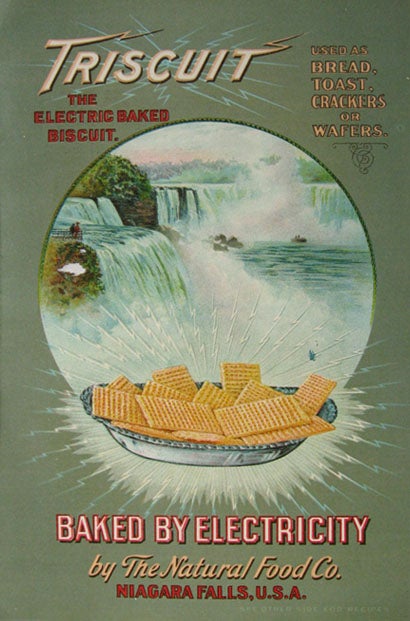If you’re working from home, what have you been munching on? Have you snuck in an American snacking staple Triscuits? Sage Boggs, a former writer for The Tonight Show, was mulling over the unique name at a party, questioning what the word “Triscuit” actually meant. The general consensus was that “tri” stood for 3 – either for “three layers” or potentially “three ingredients.” However, they were just guesses, and shockingly, Google didn’t have an official answer either. So Sage went straight to the source and emailed the makers of Triscuit, Nabisco, for an answer (fun fact – Nabisco comes from National Biscuit Company). Their response was not what he was expecting:
No business records survived which specifically explain the origins of inspiration for the word Triscuit,” the company told Boggs in an email. “But we do know the name was chosen as a fun derivation of the word ‘biscuit.’ The ‘TRI’ does not mean 3.”
The secret of the Triscuit name was later revealed when Sage found an advertisement showing that the biscuits were baked by electricity; thus, an Elec-TRI-city Biscuit! This was then confirmed by Triscuit in a tweet.

An advertisement from 1903
No Business Records Survived
Now even bigger questions remain – how is it that no business records of the naming origin survived? What happened to them? How could Triscuit not understand the meaning of their own name? Not having access to this type of information makes brands vulnerable to trademark challenges, a loss of trust, as well as issues with compliance. This is a perfect example of why you need effective information governance to future-proof your digital assets…
Data creation continues to grow in volume, velocity and variety. The resulting deposits in file shares, document management systems and other content repositories are overwhelming and can represent significant risk and cost to an organization. Information governance must adapt to address all the ways that information is now being created, shared, stored and protected across custodians and time.
[To learn more, download this complimentary Forrester Whitepaper: Digital Fragility: The Ticking Time Bomb Within Enterprises courtesy of our partner Preservica]
End to End Information Governance
While your organization’s information may not date back to the 1900s like the Triscuit name, the lesson remains the same – you need to govern and preserve your data to protect your company from digital fragility.
According to Gartner, “As formats change, software is retired and hardware becomes obsolete, the data that organizations might want to keep can be lost forever.”
End to end governance is about managing the entire information lifecycle, from creation, to deletion or long-term preservation. End to end data governance is not a “nice to have” but a real value and a key tool for risk prevention.
Content Clean-Up
How do we get from massive information stores to the select few files which need long-term digital preservation? As content grows, it becomes increasingly difficult for employees to find the content they need, as they sift through all the content they don’t need. Information Security also has a harder time protecting the crown jewels when they are mixed in with high volumes of junk and stale content. Legal and compliance teams also struggle to know what information needs to be kept for the long-term, as it’s stored together with all the Redundant, Obsolete and Trivial (ROT) data.
Start by creating a cross-repository inventory of all your content to reveal the real data in your business. By mapping and classifying your unstructured data, you can discover that data which holds no business value and identify information which needs to be preserved – such as trademarks, patents, as-built drawings and specifications and brand assets.
Given the sheer volume of unstructured data (often in the petabyte range), this data classification process cannot be achieved manually. File analysis software can be deployed to automate data discovery with customized rulesets, with active preservation future-proofing mission-critical assets.
Getting Started
With experts estimating that as much as 80% of a company’s data estate is unstructured, it can be difficult to know where to begin. When thinking about you’re the data you’re collecting and storing, you should ask:
- Does the company need to keep it?
- Does it have business value?
- Is it a duplicate?
- Does it contain private or sensitive information that must be protected in a particular way?
- Is it subject to preservation requirements under legal hold?
- Does it have to be retained over successive generations of technologies and custodians?
From Trash to Treasure
To operate at scale, you need tools, automation and advice. By pairing Active Navigation and Preservica together you can build an end-to-end information governance solution which combines file analysis with active digital preservation. This enables information professionals to facilitate content clean-up, records transfer and migration, ensuring that long-term temporary and permanent electronic records remain authentic and are accessible, now and far into the future.
[We’ve partner with Preservica and Integro to discuss End-to-End Governance: From Killing File Shares to Future-Proofing Digital Information]
If you’re interested in learning more about how Active Navigation and Preservica can help your organization comply with liability, privacy, financial and operational requirements, contact us today.
And of course, thanks to Sage Boggs for solving this cracker!
